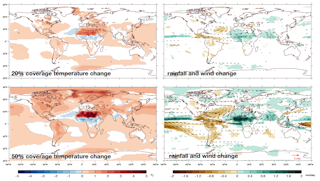Fra den ene kilden din, min utheving. Ser ut som man bare kunne fortsatt å fyre med kull? 
Drought in the Amazon, cyclones in Vietnam
Covering 20% of the Sahara with solar farms raises local temperatures in the desert by 1.5°C according to our model. At 50% coverage, the temperature increase is 2.5°C. This warming is eventually spread around the globe by atmosphere and ocean movement, raising the world’s average temperature by 0.16°C for 20% coverage, and 0.39°C for 50% coverage. The global temperature shift is not uniform though – the polar regions would warm more than the tropics, increasing sea ice loss in the Arctic. This could further accelerate warming, as melting sea ice exposes dark water which absorbs much more solar energy.
This massive new heat source in the Sahara reorganises global air and ocean circulation, affecting precipitation patterns around the world. The narrow band of heavy rainfall in the tropics, which accounts for more than 30% of global precipitation and supports the rainforests of the Amazon and Congo Basin, shifts northward in our simulations. For the Amazon region, this causes droughts as less moisture arrives from the ocean. Roughly the same amount of additional rainfall that falls over the Sahara due to the surface-darkening effects of solar panels is lost from the Amazon. The model also predicts more frequent tropical cyclones hitting North American and East Asian coasts.

Global temperature, rainfall and surface wind changes in simulations with 20% and 50% solar panel coverage of Sahara. Lu et al. (2021)
Some important processes are still missing from our model, such as dust blown from large deserts. Saharan dust, carried on the wind, is a vital source of nutrients for the Amazon and the Atlantic Ocean. So a greener Sahara could have an even bigger global effect than our simulations suggested.
We are only beginning to understand the potential consequences of establishing massive solar farms in the world’s deserts. Solutions like this may help society transition from fossil energy, but Earth system studies like ours underscore the importance of considering the numerous coupled responses of the atmosphere, oceans and land surface when examining their benefits and risks.










